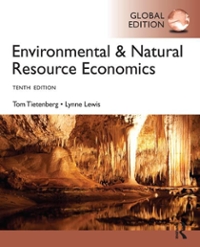Question
1. It has been suggested that Australia has one of the highest per capita GHG emissions in the world. Is this true? Fact-check this statement
1. It has been suggested that Australia has one of the highest per capita GHG emissions in the world. Is this true? Fact-check this statement and provide a graph or table to show how Australia compares globally. Make sure you clearly state where you have sourced your data from.
2. What sector produces most of Australia's GHG emissions? (Again, make sure you clearly state the source of your data).
3. Why do firms pollute?
4. What is the Kyoto Protocol and what is the Paris Agreement and what is the difference between both? What is Australia's commitment under the Kyoto Protocol and under the Paris Agreement?
5. The climate policy toolkit has, to-date, mostly focused on demand side policies (i.e. policies that affect the pollution demand curve), some of which are 'command-andcontrol' and others are market based (e.g. cap-and-trade schemes, carbon taxes).
(a) Explain what is meant by command-and-control in terms of a demand side climate change policy. What are the pros and cons of this as a policy option? 1 (b) Using a diagram, explain how a carbon tax could help reduce pollution.
(c) Using a diagram or diagrams, explain how a cap-and-trade scheme could result in pollution reduction.
(d) What is the Emissions Reduction Fund and what are its pros and cons?
(e) Of the four policy options above ((a) to (d)) which one do you favour as a demandside policy and why?
(f) Suppose the government decided to issue tradeable permits for a certain form of pollution, does it matter for economic efficiency whether the government allocates the permits to firms or whether it auctions them off? Why or why not?
6. When it comes to policies aimed at tackling GHG associated with fossil fuels, Green and Denniss (2018) advocate the use of supply side policies over demand side policies. What sorts of supply side policies do they advocate and why (from an economic perspective, not a political perspective) do they favour them over demand side policies? Explain using diagrams as appropriate.
7. What do Green and Denniss (2018) see as the political advantages of supply side policies over demand side policies?
8. If you were the Prime Minister would you assign responsibility for energy policy and climate policy to the same minister? Why or why not?
Step by Step Solution
There are 3 Steps involved in it
Step: 1

Get Instant Access to Expert-Tailored Solutions
See step-by-step solutions with expert insights and AI powered tools for academic success
Step: 2

Step: 3

Ace Your Homework with AI
Get the answers you need in no time with our AI-driven, step-by-step assistance
Get Started


